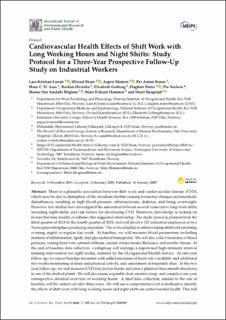| dc.description.abstract | There is a plausible association between shift work and cardiovascular disease (CVD), which may be due to disruption of the circadian rhythm causing hormonal changes and metabolic disturbances, resulting in high blood pressure, atherosclerosis, diabetes, and being overweight. However, few studies have investigated the association between several consecutive long work shifts, including night shifts, and risk factors for developing CVD. Moreover, knowledge is lacking on factors that may modify or enhance this suggested relationship. The study period is planned from the third quarter of 2018 to the fourth quarter of 2021, and will involve 125 industrial employees at two Norwegian enterprises producing insulation. The work schedule is either rotating shiftwork (morning, evening, night) or regular day work. At baseline, we will measure blood parameters, including markers of inflammation, lipids, and glycosylated hemoglobin. We will also collect measures of blood pressure, resting heart rate, arterial stiffness, carotid intima-media thickness, and aerobic fitness. At the end of baseline data collection, a subgroup will undergo a supervised high-intensity interval training intervention for eight weeks, initiated by the Occupational Health Service. At one-year follow-up, we repeat baseline measures with added measures of heart rate variability and additional five weeks monitoring of sleep and physical activity, and assessment of respirable dust. At the two year follow-up, we will measure CVD risk factors before and after a planned three-month shutdown in one of the studied plants. We will also assess respirable dust, monitor sleep, and compile a one-year retrospective detailed overview of working hours. A final data collection, similar to the one at baseline, will be carried out after three years. We will use a comprehensive set of methods to identify the effects of shift work with long working hours and night shifts on cardiovascular health. This will provide new knowledge on the association between early manifestations of CVD and occupational exposure to shift work. Further, we can study whether work organization such as extensive overtime, sleep loss, and dust exposure have detrimental effects, and if a three-month cease in shift work or increased physical activity will modify early manifestations of CVD | |
